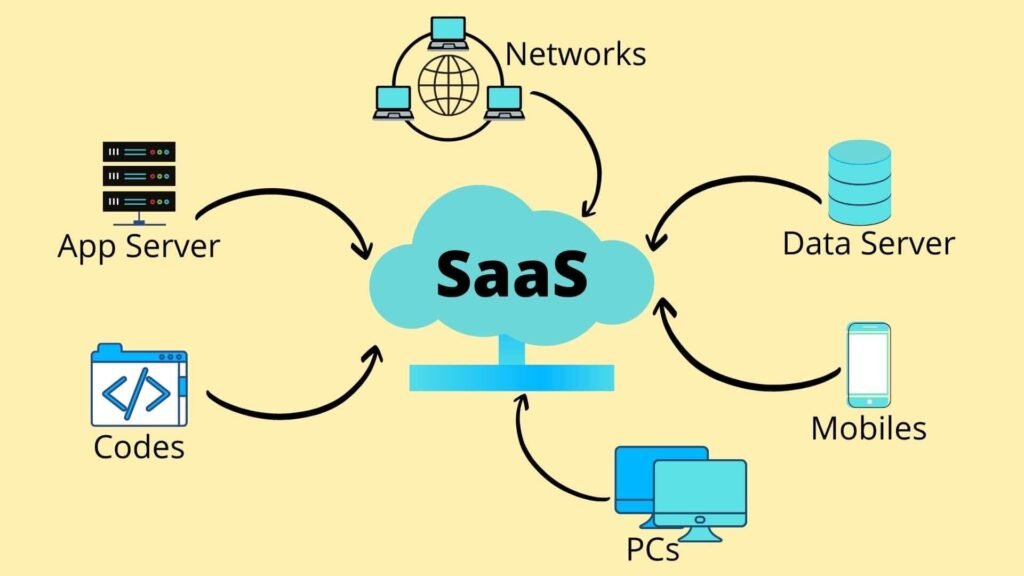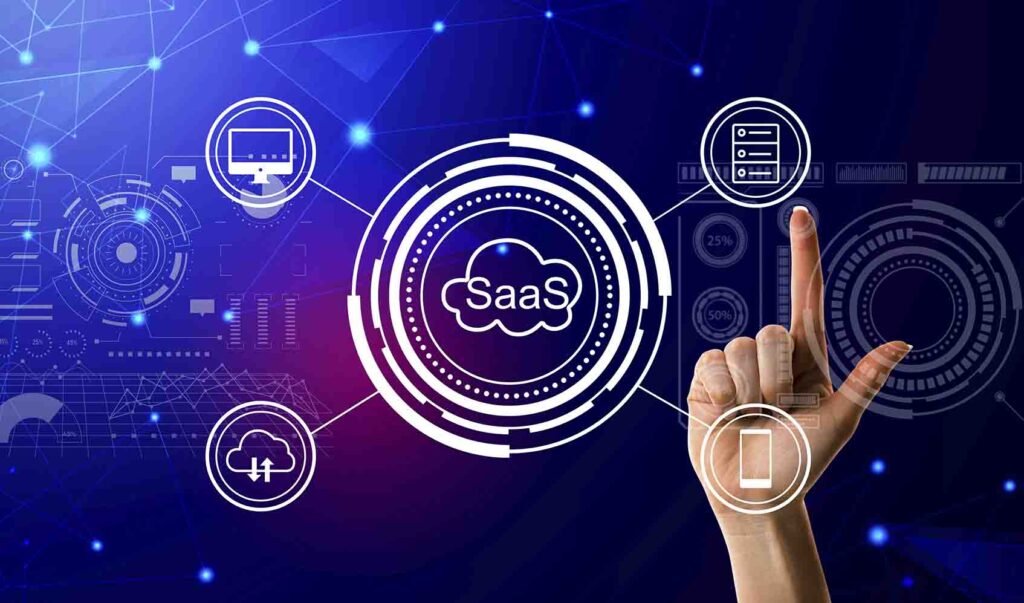Being a successful SaaS product and service provider and making sure your service or SaaS product is of optimal use requires a significant amount of time, skill, and resources. And not every business or organization is capable of providing all three. That’s where outsourcing SaaS development comes in. It is reported that IT outsourcing will reach to $777.7 billion with a CAGR of 10.99%. This clearly signifies that Outsourcing SaaS development isn’t just cost-saving or reducing hassle, but it is a strategic planning for faster and innovative growth. Understand what SaaS application outsourcing is, its benefits, limitations, and Agile development for SaaS.
What is SaaS Development & Why Outsourcing Matters Today?
In simple words, software that people can use online without installing anything, like heavy on-premise infrastructure or hardware, is called SaaS. You might have come across applications like Google Workspace, Zoom, or Slack. These are all SaaS applications that run on clouds, and you just need to log in to use them. SaaS app developers are responsible for building and maintaining these applications to make them run in a secure, fast, and resourceful manner. They keep on making necessary and timely updates.
The global outsourcing market was worth $92.5 billion in 2019, and almost 59% of the companies outsource to reduce costs. Hiring external experts has become a common thing in business these days. Some tasks or a set of services and processes require a robust workflow, a well-built infrastructure, and a team to carry them out. But for companies, sometimes it becomes difficult to do this due to various reasons, like budget and manpower constraints. This is the reason outsourcing has become a great tool for businesses to complete tasks with precision and expertise in an affordable manner.

In this blog, we will learn about SaaS application outsourcing and how offshore SaaS development works. And what are the benefits and risks involved in outsourcing SaaS development?
How do Companies Outsource SaaS Development?
Here is a full process of how SaaS development outsourcing takes place.
1. Set Goals & Requirements
Make the external experts clearly understand what you want from the project and what the SaaS product fulfills. Mention your expectations, set timelines, and budget allocations.
2. Decide on Outsourcing Model
Choose the correct outsourcing model that is suitable for your needs. It can be staff augmentation, dedicated team outsourcing, or project-based outsourcing.
3. Have a Right Partnership
Choose experienced professionals with in-depth knowledge about SaaS development, check their professional projects and reviews by clients. And understand their level of know-how in technical trends. For offshore outsourcing, keep in mind the time differences, language barriers, and cultural compatibility.
4. Documentation
Make sure to set proper contracts and agreements with the company you partner with, and mention all important and necessary aspects in the contract. And sign NDAs and SLAs to have IP protection and ensure timely and quality deliveries.
5. Collaboration & Communication
Decide what tools you will mutually consider to manage the project, have communication, and version control. Some examples are Jira, GitHub, and Slack. Organize regular meetings for updates and especially in the case of offshore outsourcing, to keep up with the different time zones.
6. Roll Out
After sharing the requirements details and finalizing everything on the contract, kickstart the development phase. Methods like agile development for SaaS or Scrum are often used for development to happen in phases and sprints.
7. Track Progress & Quality Checks
Keep viewing how the development is going and what milestones and deliveries are being hit. Ensure to have testing and Q&A to know if the development is meeting the standards.
8. Deployment & Handover
Go live in the environment and deploy your SaaS applications to the cloud. Do have proper documentation and provide training if needed.
9. Support & Maintenance
The outsourcing partners and teams often give post-launch support to help fix bugs, ensure updates, and provide scaling assistance. Offshore teams can handle 24/7 support if required.
Related: What is iPaaS & SaaS? Key Benefits, Use Cases, and Differences
Types of SaaS Development Outsourcing Models
| Outsourcing Model | Description | Advantages | Challenges | Best For |
|---|---|---|---|---|
| 1. Onshore Outsourcing | Type of outsourcing where you partner with a company in the same country | No language or cultural barriers, easier collaboration, and legal compliance | Higher costs compared to offshore options, limited talent pool | Companies looking for communication as a priority and wish to keep operations local |
| 2. Nearshore Outsourcing | Working with teams in nearby or neighboring countries Example U.S. → Mexico, the UK → Poland | Like time zones, it is easy to commute with moderate cost-cutting | Smaller cost gap than offshore. May still face cultural differences | Businesses looking for a balance between cost and collaboration convenience |
| 3. Offshore Outsourcing | Partnering across continents, not just neighboring countries like Europe → India, U.S. → Philippines, to access affordable global talent | Significant cost reduction, access to large & skilled talent pools, 24/7 operations possible | Time zone and communication gaps, cultural differences, and data security concerns | Companies focused on cost efficiency and rapid scaling |
| 4. Staff Augmentation | Combining external professionals with your internal team for specific roles or skill gaps | Full control over project management, flexible and scalable staffing, with access to niche expertise | Requires strong internal management and depends on your in-house team’s coordination | Businesses needing extra developers or short-term skill support |
| 5. Dedicated Development Team | A vendor provides a remote team that works exclusively on your project, acting as an extension of your company | Deep product understanding, long-term stability, and easier alignment with company goals | Slightly higher cost than project-based, needs proper onboarding and communication setup | Long-term SaaS projects with evolving features or regular updates |
| 6. Project-Based Outsourcing | The outsourcing partner manages the project from planning to delivery based on fixed requirements | Minimal management effort, fixed timelines, cost estimates, and quick turnaround for defined projects | Limited flexibility for changes, less control over daily progress | Short-term, well-defined projects with clear goals and deadlines |
Benefits of Outsourcing SaaS Development
Let’s know the main reasons why companies outsource SaaS Development. Software outsourcing revenue is expected to show an annual growth rate (CAGR 2023-2027) of 7.54%.
- Reducing cost for the development of applications is one of the main reasons companies choose to outsource SaaS development. It avoids the hassle of hiring a full-time team, office space, and expensive tools. 70% of the development costs can be saved by outsourcing.
- You can leverage expertise and talent across the globe by going for offshore SaaS development. Get a specialized SaaS skillset and fresh ideas from anywhere in the world.
- When teams work across time zones, you can experience faster development, and your SaaS product can be launched ahead of competitors.
- Allows you to focus on your core business.
- You have flexibility, along with scalability. It allows you to adjust team size and skills as per project needs without worry of permanent hiring.
- Outsourcing partners mainly use high-tech and cloud-based tools. In this way, your products get a lead in the technical aspect.
- Most of the vendors offer amazing post-launch support, keeping maintenance and updates in place with security and stability.
Risks of Outsourcing SaaS Development
| Risk | Description | Mitigation |
|---|---|---|
| Communication Gaps | Language barriers, time differences, and unique cultures can cause miscommunications. | Clear communication channels, regular video conferences, and aligned project management tools can solve this issue. |
| Quality Issues | Outsourced codes, at times, don’t keep up with the demands. | Keep your standards clear and run regular testing and code reviews. |
| Data Security & Privacy | Sometimes, in terms of sharing detailed requirements, it might include some sensitive information. | Sign NDAs, go for verified vendors, and make sure they adhere to data protection regulations. |
| Different Time Zone | Time differences can bring in late responses. | Schedule your deadlines, overlapping hours, and use parallel communication tools. |
| Hidden Costs | Unexpected charges for additional features or extended timelines. | Define a detailed contract with pricing and deliverables upfront; track budget regularly. |
| Dependency on Vendor | Lost long-term control due to overreliance on external teams. | Always have your internal plan B with inside expertise and exit strategies in line. |
| Project Delays | Lack of coordination and communication, misunderstandings. | Go for Agile methods, keep meetings, and track steps to stay updated. |
Conclusion: Real Case
Outsourcing SaaS development can give businesses several advantages and keep them ahead of the competition. It is a fast and efficient way to develop and launch your SaaS product. Also, companies can focus thoroughly on their main business and services they offer by working with offshore SaaS development.
Domino’s Pizza’s outsourcing is a great example of how it can be beneficial in various ways. Domino’s Pizza replaced its 7-year-old IT service management systems with Atlassian’s Jira Service Management. This outsourcing was an outstanding move that streamlined operations in 3,800 outlets worldwide. They saw improved delivery efficiency and better service quality as backend processes were automated and redundancies were reduced.
Now it’s your time to choose the right SaaS development outsourcing partner and stay ahead while leveraging the benefits of outsourcing SaaS development.
Related: SaaS Business Intelligence: Be On Top In Business Just By Organizing Data








